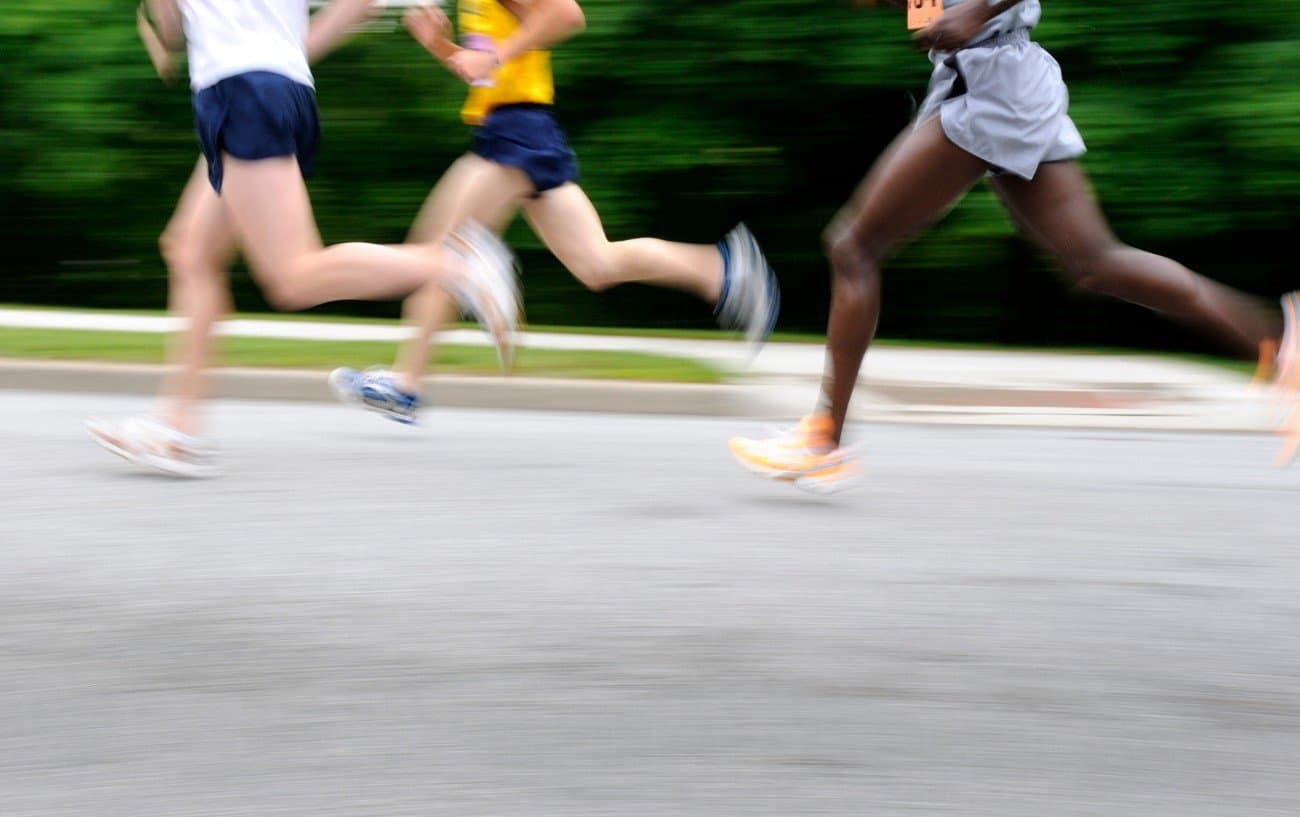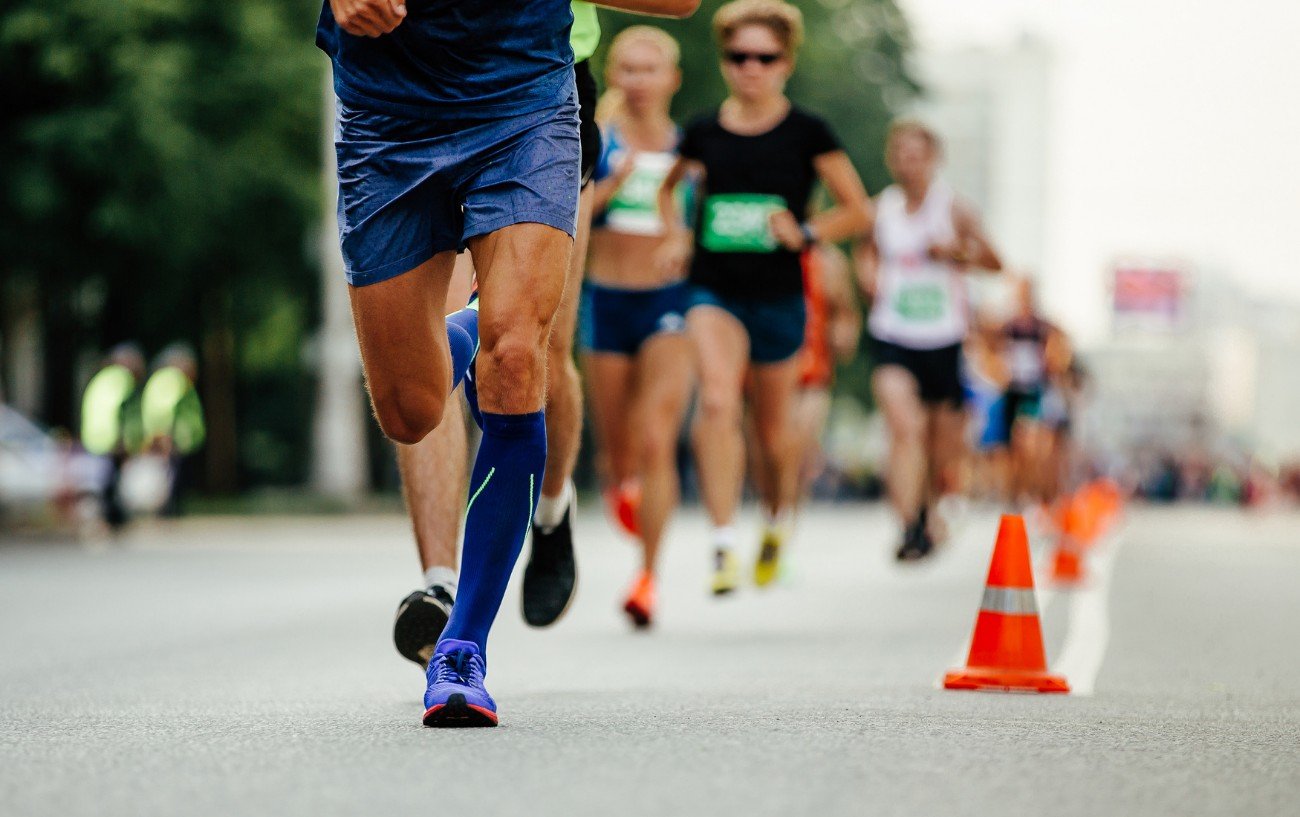A good 10k time is 55 minutes or faster: now, “good” in this case can be subjective, so in this post we get into the data and break down average 10k times by age, sex, and country.
For newer or irregular runners, breaking the 60 minute 10k mark is a great goal to aim for.
A 10k time under 50 minutes averages about 8 minutes a mile.
More advanced runners will be able to finish under 43 minutes, averaging just under 7 minutes a mile.
By some standards, a male elite runner should be able to run a 10k in under 38 minutes and a female elite runner in under 45 minutes. Though, elite qualifying standards are race-specific and vary.
For casual runners, it is more difficult to say exactly what a ‘good’ 10k time is, as race time varies greatly depending on age group. You could consider a ‘good’ 10k time for intermediate runners as being greater than the average for their age group (scroll down to view these categories for yourself).

Typical 10K Times By Age, Sex, and Ability
Defining Running Ability Levels
To define the ability levels we’ve included, we used Jack Tupper Daniels’ VDOT Levels (based on VO2 max).
Daniels provides predicted times across different distances for each of the VDOT Levels for men and women (available here), which we’ve used in our table as the benchmark times for the 18-39 age range.
Here’s how we’d define each of the levels listed in our table, along with the VDOT that Daniels assigns to them:
- Beginner (Male VDOT 35/Female VDOT 31.4): By beginner, we’re not referring to somebody straight off the couch who’s shown up to their first race with no training, as there’s too much variation in terms of baseline fitness and physique to provide a useful guideline time. Instead, in this sense, we’d consider a beginner to be somebody who’s relatively new to distance running, perhaps entering their first race, but who is taking their training fairly seriously and has a decent base level of fitness. However, they lack experience in building an effective training program and in pacing themselves during a race.
- Novice (VDOT 40/35.8): You’re still running casually, but with increasing experience and commitment to training. You’ve completed several races at this distance, and are looking to improve your PB in each one. The vast majority of runners will fall into one of these first two categories.
- Intermediate Recreational (VDOT 50/44.6): You’re taking running increasingly seriously, and it’s getting more difficult to beat your previous PBs. You might have joined an athletics club or started training with a running coach, and while you’re unlikely to be competing for local race victories, you’d be hoping to finish high up the field.
- High-Level Recreational (VDOT 60/53.4): You train seriously with a professional coach, and are among the top-performing runners in your athletics club competing for victories in local races. You are likely approaching the peak of your potential performance, with a substantial time investment in training each week.
- Sub-Elite (VDOT 70/62.2): You are one of the strongest runners in your region, and may even compete nationally, although you’re unlikely to compete for the top positions.
- National Class (VDOT 75/66.6): You are one of the finest runners in your country, competing for victories against all but the very best athletes in the sport. You likely run either full-time as a professional, or you make a flexible job fit around your training.
- Elite (VDOT 80/71): You are at the pinnacle of the sport, competing for victories at the most prestigious races and representing your country at major international events.
A counterintuitive point worth mentioning – which isn’t reflected in the data – is that among amateur long-distance runners, performances tend to improve until the age of around 50.
Because non-elite runners are unlikely to be running at their maximum genetic potential, the drop-off in their maximum potential is outweighed by their increased experience, which both enables them to pace themselves more effectively through a race and means they better understand how to build an effective training regime that works for them as an individual.
10K Times: Male Runners
| Age Group | Beginner | Novice | Intermediate Recreational | High-Level Recreational | Sub-Elite | National Class | Elite | World Record |
|---|---|---|---|---|---|---|---|---|
| VDOT 35 Level 1 | VDOT 40 Level 2 | VDOT 50 Level 4 | VDOT 60 Level 6 | VDOT 70 Level 8 | VDOT 75 Level 9 | VDOT 80 Level 10 | – | |
| 18-39 | 56:00 | 50:00 | 41:30 | 35:30 | 31:00 | 29:00 | 27:30 | 26:24 |
| 40+ | 59:00 | 52:30 | 43:30 | 37:00 | 32:30 | 31:00 | 29:00 | 27:48 |
| 45+ | 1:01:30 | 55:00 | 45:30 | 38:30 | 34:00 | 32:00 | 30:30 | 28:56 |
| 50+ | 1:04:00 | 57:00 | 47:00 | 40:30 | 35:30 | 33:30 | 31:30 | 30:04 |
| 55+ | 1:07:00 | 1:00:00 | 49:30 | 42:30 | 37:00 | 35:00 | 33:00 | 31:40 |
| 60+ | 1:09:30 | 1:02:00 | 51:30 | 44:00 | 38:30 | 36:30 | 34:30 | 32:48 |
| 65+ | 1:13:30 | 1:05:30 | 54:00 | 46:00 | 40:30 | 38:00 | 36:00 | 34:32 |
| 70+ | 1:19:00 | 1:10:30 | 58:30 | 50:00 | 43:30 | 41:00 | 39:00 | 37:12 |
| 75+ | 1:25:30 | 1:16:00 | 1:03:00 | 54:00 | 47:00 | 44:30 | 42:00 | 40:10 |
| 80+ | 1:31:00 | 1:21:30 | 1:07:30 | 57:30 | 50:30 | 47:30 | 45:00 | 42:58 |
10K Times: Female Runners
| Age Group | Beginner | Novice | Intermediate Recreational | High-Level Recreational | Sub-Elite | National Class | Elite | World Record |
|---|---|---|---|---|---|---|---|---|
| VDOT 31.4 Level 1 | VDOT 35.8 Level 2 | VDOT 44.6 Level 4 | VDOT 53.4 Level 6 | VDOT 62.2 Level 8 | VDOT 66.6 Level 9 | VDOT 71 Level 10 | – | |
| 18-39 | 1:01:30 | 55:00 | 45:30 | 39:00 | 34:30 | 32:30 | 30:30 | 28:46 |
| 40+ | 1:07:30 | 1:00:30 | 50:00 | 43:00 | 37:30 | 35:30 | 33:30 | 31:37 |
| 45+ | 1:11:30 | 1:04:00 | 53:00 | 45:30 | 40:00 | 37:30 | 35:30 | 33:28 |
| 50+ | 1:13:00 | 1:05:30 | 54:30 | 46:30 | 41:00 | 38:30 | 36:30 | 34:14 |
| 55+ | 1:17:30 | 1:09:30 | 57:30 | 49:30 | 43:00 | 41:00 | 38:30 | 36:16 |
| 60+ | 1:18:30 | 1:10:00 | 58:00 | 50:00 | 44:00 | 41:30 | 39:00 | 36:43 |
| 65+ | 1:26:00 | 1:17:00 | 1:04:00 | 54:30 | 48:00 | 45:30 | 43:00 | 40:17 |
| 70+ | 1:34:00 | 1:24:30 | 1:10:00 | 1:00:00 | 52:30 | 49:30 | 47:00 | 44:09 |
| 75+ | 1:45:30 | 1:34:30 | 1:18:30 | 1:07:30 | 59:00 | 55:30 | 52:30 | 49:31 |
| 80+ | 1:56:00 | 1:44:00 | 1:26:00 | 1:14:00 | 1:04:30 | 1:01:00 | 58:00 | 54:17 |
How We Produced This Data
The tables above have been carefully created to give our readers performance benchmarks and to enable comparisons of relative performance adjusted for age and sex.
As mentioned above, we used Jack Tupper Daniels’ VDOT Levels and associated predicted performances in our table as the benchmark times for the 18-39 age range.
For the age-graded world records, we’ve used the official records ratified by the World Association of Masters Athletes (WMA), correct as of 18 March 2024. (It should be noted we used road running world records, rather than track world records.)
To translate the times for ability levels across different age grades, we used our 18-39 benchmark times to establish each ability level as a percentage of the world record for a given age group.
For example, our “elite” men’s 10K time for the 18-39 range was 27:41, which is 104.86% of the world record of 26:24.
So, when calculating the “elite” times for other age grades, we multiplied the respective world records by 104.86%. We replicated this approach across all of the listed ability levels.
It should be noted that this method does create some inconsistencies, with the performance gaps between certain age groups being larger than others because a particular world record happens to be an outlier.
However, we found the resulting data more reliable and with a more accurate representation of performance drop relative to age than we achieved when comparing our results to existing age-grade calculators.
For readability, we rounded all times to the nearest 30 seconds, except for all of the world records, which we left in their original form.
How long is a 10k?
A 10k, or 10,000 meters, is 6.2 miles or 25 laps around an Olympic-sized track.
A 10k is also 6 miles 376 yards or 32,808 feet 5 inches. And, it goes without saying a 10k is twice as long as a 5k which is 3.1 miles.
The 10k is the longest standard track event and is often raced in road races and cross country events.
What is the fastest 10k time?
The world record fastest 10k time for men is 26:11:00, set on October 7, 2020 by Joshua Cheptegei of Uganda! That is 4:12 mile running pace!
The world record fastest 10k time for women is 29:01:03, set on June 8, 2021, by Letesenbet Gidey of Ethiopia. That’s 4:40 a mile!

What is the average finish time by country?
According to RunRepeat’s State of Running Report1 The State of Running 2019. (2019). Athletic Shoe Reviews; RunRepeat.com. https://runrepeat.com/state-of-running:
- Switzerland has the fastest 10k finishers with an average finish time of 52 minutes 42 seconds.
- Luxemburg is in second place with 53 minutes 6 seconds.
- Portugal comes in third with an average 10k time of 53 minutes 43 seconds.
- Thailand and Vietnam are among the slowest nations in the distance
Looking specifically at male rankings:
- The Swiss are still number one with 48 minutes 23 seconds, and
- Luxembourg is second with 49 minutes 58 seconds.
- The Norwegians are in third place with an average time of 50 minutes 1 second.
- Portuguese women are first in 10Ks with 55 minutes 40 seconds. They are faster than the men from Vietnam, Nigeria, Thailand, Bulgaria, Greece, Hungary Belgium, Austria, and Serbia, according to the report.

How long does it take to run a 10k?
A beginner runner will likely take have an average pace of 12-15 minutes a mile. Thus, it may take between 70 to 90 minutes for a new runner to finish a 10k.

What impacts how fast you can run a 10k?
There are many factors that can influence running performance for a 10k. These factors include your current level of fitness, age, gender, running shoes, training program, weather conditions, hydration, and ability.
The more you run, the more you can positively impact your cardiovascular and musculoskeletal health which will make you run faster.
Having a good training program or a running coach will definitely help you smash that long distance.

How many miles a week should I run to train for a 10k?
Beginner runners should run at least 15 miles a week to train for a 10k. More advanced runners will run 40 miles a week to train for a 10k.
How long should I train to run a 10k?
Most 10k training plans will be 12-14 weeks long and include a base phase before introducing speed and race-paced workouts along with tempo runs. Couch-to-10k programs will include only easy running.
Should I run a 10k before my 10k race?
If you have an upcoming race, It is not necessary to run a 10k before your 10k race but is helpful.
Unlike the marathon or half marathon, running the full 10k in your training before race day will not unnecessarily tax your system and hurt recovery.
Instead, running a full 10k before your 10k race will give you the confidence that your body can cover the distance.
It will also spur physiological changes such as stronger bones and muscles along with increased capillary density and mitochondria to perform better on race day.
What are the benefits of running a 10k?
Running longer distances has a host of mental and physical benefits2 Lee, D., Pate, R. R., Lavie, C. J., Sui, X., Church, T. S., & Blair, S. N. (2014). Leisure-Time Running Reduces All-Cause and Cardiovascular Mortality Risk. Journal of the American College of Cardiology, 64(5), 472–481. https://doi.org/10.1016/j.jacc.2014.04.058 that include but are definitely not limited to:
- decreased stress, anxiety, and depression;
- increased memory, mental acuity, and happiness;
- improved cardiovascular health, blood pressure, and cholesterol;
- healthier bodyweight;
- and stronger bones, tendons, muscles, and joints.
For a runner looking to run faster, training for a 10k can help you run faster at all distances.
- For distances shorter than 10k, training for a 10k can improve your lactate threshold, thereby improving your endurance and allowing you to run faster for longer.
- For distances longer than 10k, training for a 10k can add power to your training, also improving your speed and endurance.
Similarly, a 10k is a fantastic progression for couch-to-5k runners who have mastered the 5k and are ready to take their running to the next level.

How can I run a faster 10k? – 3 ways
There are 3 key ways to improve your 10k run time:
1. Lift weights (strength training)
Strength training using the 5 basic movement patterns of lift, hinge, push, pull, and carry, two times a week may improve your 10k performance3 Tanaka, H., & Swensen, T. (1998). Impact of resistance training on endurance performance. A new form of cross-training? Sports Medicine (Auckland, N.Z.), 25(3), 191–200. https://doi.org/10.2165/00007256-199825030-00005 by improving your running stride power and efficiency. Additionally, strength training can help to correct muscular imbalances and improve posture4 Blagrove, R. C., Howatson, G., & Hayes, P. R. (2017). Effects of Strength Training on the Physiological Determinants of Middle- and Long-Distance Running Performance: A Systematic Review. Sports Medicine, 48(5), 1117–1149. https://doi.org/10.1007/s40279-017-0835-7, reducing the chance of injury and enhancing your performance.
Adding plyometrics to these sessions has also been shown to make you run faster5 Spurrs, R. W., Murphy, A. J., & Watsford, M. L. (2003). The effect of plyometric training on distance running performance. European Journal of Applied Physiology, 89(1), 1–7. https://doi.org/10.1007/s00421-002-0741-y!
2. Run strides
Running strides improves neuromuscular connections and improves running efficiency (due to fewer wasted movements).
Add about four strides after easy runs two times a week. Running drills can also help you run faster by improving communication from your brain to your muscles.

3. Vary your runs
Do different types of running with varying speeds to build the different energy systems in your body, improve muscle fiber activation, and increase musculoskeletal strength.
The types of runs you should do in your training include hills, threshold runs, race-pace intervals, fartleks, and VO2 max intervals. In particular, hill sprints and other types of interval training based around speed work are proven to be effective in increasing running speed for distance runners.
How to run a 10k?
The most tried-and-true race strategy for the 10k is to run negative splits. That means you will start out slower than your goal pace and progressively run faster for each mile.
The negative split strategy has been used to set world records from every distance from the 1500 to the marathon.
To run a negative split:
- First decide on your goal race pace for the 10k.
- Then, run your first 2 miles about 5 to 10 seconds slower than your goal race pace.
- Gradually pick up the pace so that you are running at your goal pace for miles 3 and 4.
- For the 5th mile, aim to run 5 to 10 seconds faster than goal race pace.
- In the final 1.2 miles, give it all you got! Run as fast as you can and leave nothing in the tank!

10 Tips to Run a 10k
1. Find a training plan. Pick a training plan that matches your current fitness level and schedule.
2. Pick a race. Then pick a goal race that fits within the timeframe of your training schedule.
3. Never skip the warm-up or cool-down. To avoid injury, always be sure to warm up and cool down with your runs, especially ones that involve fast running.
4. Build your mileage slowly. Do not increase your runs by more than 10 percent week-over-week in your training, or risk injury. If you want to cross the finish line with a good time, you need to be training regularly, as opposed to doing too much at once, then having to stop because you’ve overtrained.
5. Practice makes perfect. Race a 10k in your training to know what a race feels like and get comfortable with the process and distance.
6. Vary your workouts. To get faster, you need to do more than just run. Run at different paces to build your speed and endurance.

7. Recover as hard as you run. You are always only as good as your recovery. So, be sure to get at least 7 to 8 hours of rest. Stretch. Foam roll. Take weekly rest days. And, be sure to maintain a healthy diet.
8. Find a friend. Run with friends to ensure accountability and guard against burnout.
9. Taper. In the week before your workout, run less mileage and do not strength train. Allow your body to build itself back up so that you are strong on race day.
10. Finish strong. Never run a race feeling like you could have given it more than you did. Finish fast and give it your all!
We’d love to help you conquer the 10k distance!
Check out our 10k training plans!
For the beginners:
For active folk who are looking to challenge themselves:
For runners looking to bag at 10k PR:

You repeated yourself (sentences two & three are identical):
By some standards, a male elite runner should be able to run a 10k in under 38 minutes and a female elite runner in under 45 minutes. Though, elite qualifying standards are race-specific and vary. Though, elite qualifying standards are race-specific and vary.
weird, doesn’t look that way when I check the article – can you have a 2nd look?
Thomas from Marathon Handbook
Yes… this sentence is repeated like this:
Though, elite qualifying standards are race-specific and vary. Though, elite qualifying standards are race-specific and vary.
Thanks, fixed it!
Thomas